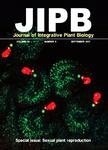Oxylipin Pathway in Rice and Arabidopsis
Oxylipin Pathway in Rice and Arabidopsis作者机构:Section of Plant Biology University of California-Davis Davis CA 95616 USA
出 版 物:《Journal of Integrative Plant Biology》 (植物学报(英文版))
年 卷 期:2007年第49卷第1期
页 面:43-51页
核心收录:
学科分类:0710[理学-生物学] 071001[理学-植物学] 07[理学]
主 题:aldehydes allene oxide synthase Arabidopsis hydroperoxide lyase jasmonates oxylipin pathway rice
摘 要:Plants have evolved complex signaling pathways to coordinate responses to developmental and environmental Information. The oxylipin pathway Is one pivotal lipid-based signaling network, composed of several competing branch pathways, that determines the plant's ability to adapt to various stimuli. Activation of the oxyllpln pathway Induces the de novo synthesis of biologically active metabolltes called "oxyllplns". The relative levels of these metabolltes are a distinct indicator of each plant species and determine the ability of plants to adapt to different stimuli. The two major branches of the oxyllpln pathway, allene oxide synthase (AOS) and hydroperoxlde lyase (HPL) are responsible for production of the signaling compounds, jasmonates and aldehydes respectively. Here, we compare and contrast the regulation of AOS and HPL branch pathways In rice and Arabidopsis as model monocotyledonous and dicotyledonous systems. These analyses provide new Insights Into the evolution of JAs and aldehydes signaling pathways, and the complex network of processes responsible for stress adaptations In monocots and dicots.



